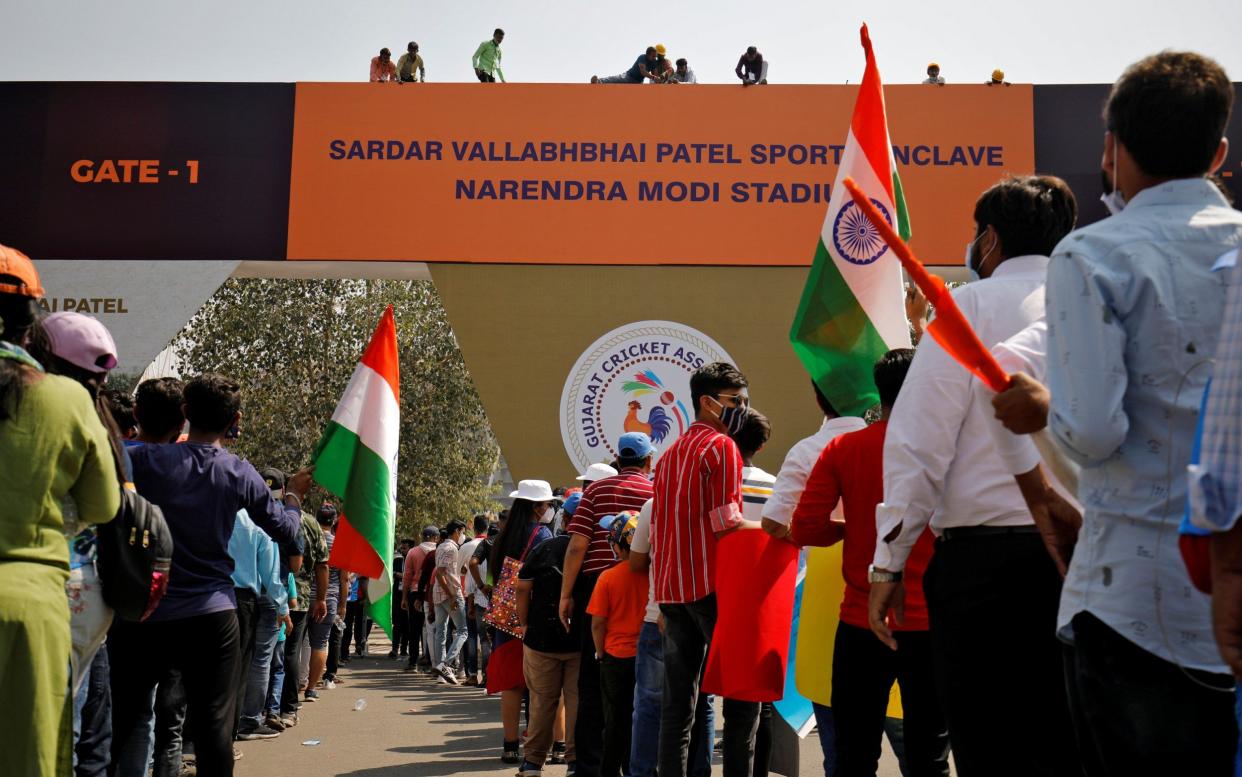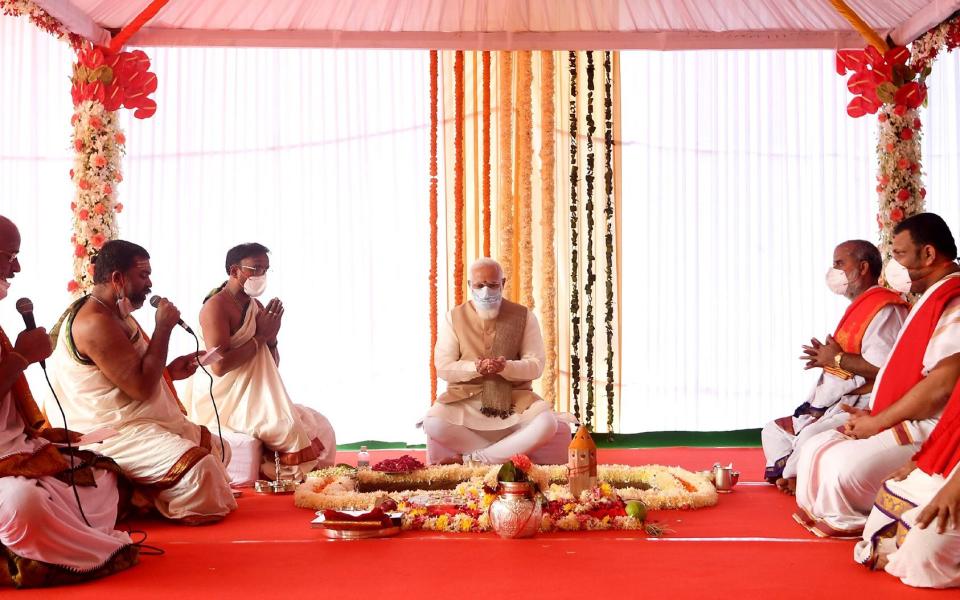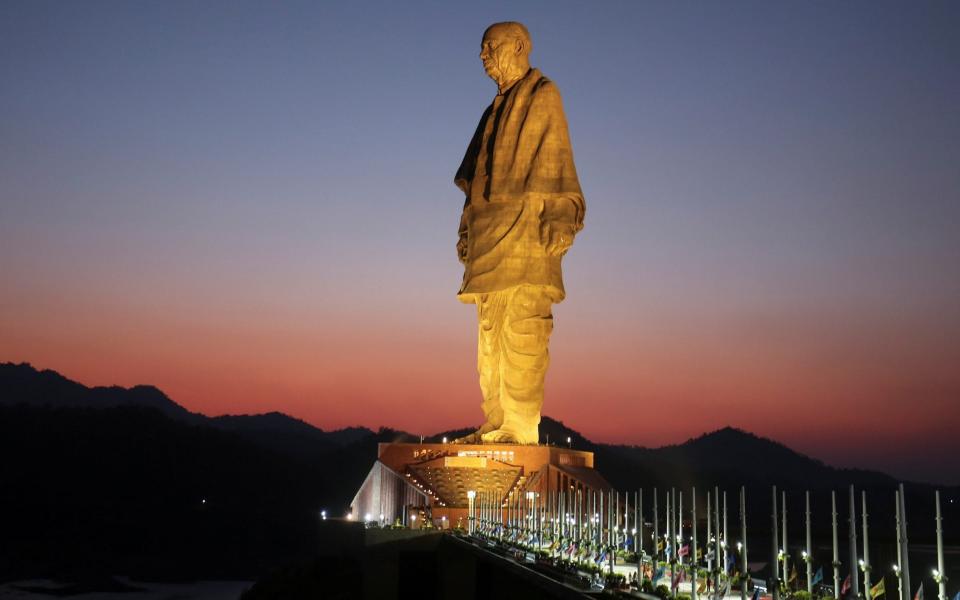Modi accused of remaking India in his image after renaming world's largest stadium after himself

- Oops!Something went wrong.Please try again later.
The renaming of the world's largest cricket stadium after India's prime minister, has renewed accusations of narcissism and a growing personality cult around the nationalist leader, in the latest row over politically-driven name changes in the country.
The announcement that the 132,000-seat venue formerly known as Sardar Patel Stadium in Ahmedabad would be become the Narendra Modi Stadium sparked delight in his supporters and scorn from political opponents.
Mr Modi's gift for oratory and keen populist instincts have made him by far the most popular politician in India, and in 2019 won his Bharatiya Janata Party (BJP) a second term.
Yet he has also attracted accusations of vanity and attempting to glorify himself as the founder of a new Hindu India. Critics last week asked whether the stadium's new name was an attempt to bolster his legacy with a relabelling spree.
Dedicating sports stadiums to former prime ministers is common in India, but renaming such a high-profile venue for a sitting leader is rare.
The prime minister's allies hit back by pointing to a host of public buildings and government projects named after members of the Congress' Nehru-Gandhi dynasty that governed India for decades.
Mr Modi's nationalist BJP party has also gained a reputation for aggressively pursuing name changes. The intent behind them ranges from pure vanity and political point-scoring to more ambitious attempts to rewrite history and eclipse the role played by non-Hindus in the nation, commentators say.

In one of the most recent examples, in December the government announced the Rajiv Gandhi Biotechnology Centre in Kerala would be renamed to celebrate MS Golwalkar, a Hindu nationalist ideologue.
While previous governments have replaced colonial Anglicised names, such as changing Bombay to Mumbai and Madras to Chennai, the current government has been accused of going further to try to erase non-Hindu identities and particularly Muslim history.
In 2018, the Modi government approved the renaming of 25 towns and villages across India, and among the pending proposals is one for the state of West Bengal to be switched to Bangla.
That year, the BJP-ruled state of Uttar Pradesh, which has the highest Muslim population in India, changed the name of Allahabad to Prayagraja to reference a Hindu pilgrimage site.
The name Allahabad had dated to the 16th century and the Mughal Emperor Akbar. "Today, the BJP government has rectified the mistake made by Akbar," a BJP official was quoted as saying when the name was altered.
Indian historian and novelist Prof Mukul Kesavan said the renaming of the stadium was trivial compared to the campaign to rename Muslim sites.
“With the changeover from Allahabad to Prayagraj, what we are seeing is an assertion that India is a Hindu state and its place names should be appropriately Hindu. And that is a dangerous kind of renaming. We have to distinguish between different kinds of renaming – some kinds of renaming are acts of individual vanity like the cricket stadium. But other kinds of renaming are historically more important. They are trying to erase historical meaning.”
He said: “When they change the name of a city, they change our history, language, cultural references. They make us foreigners in our own country. Whether we are Muslim, Hindu or Sikh, when you are officially declared to be dead then what happens you no longer recognizes the world around us and this is the ambition.”

Mr Modi's opponents say he has not only used name changes to boost his profile and secure a lasting grip on the country's cultural fabric.
In 2018, he unveiled the world’s largest statue in a bid to showcase his position as leader of a new, world-beating India. The 597ft “Statue of Unity” depicts Vallabhbhai 'Sardar' Patel, one of the heroes of India’s independence movement.
His grandiose plan to redevelop the Indian parliament and Delhi's central vista were last year dismissed by the acclaimed Indian-born sculptor Anish Kapoor as an “expensive vanity project”,.
Mr Kapoor said the project was a “way of placing himself at the centre and cementing his legacy as the ruler-maker-builder of a new Hindu India”.
Prof Rakesh Sinha, a BJP member of parliament, said the renaming of cities and towns “ is returning to originality” and said Allahabad had originally been called Prayagraj.
As for the parliament plans, he said India should decolonise its architecture.
“Why should we go with colonially designed structures? Why not independent India design its own structure? We are decolonizing not only minds but also architecture.
“Decolonization is not about Britishers having left India, it means we have to erase everything and anything which is making a negative impact on the minds of our people.

